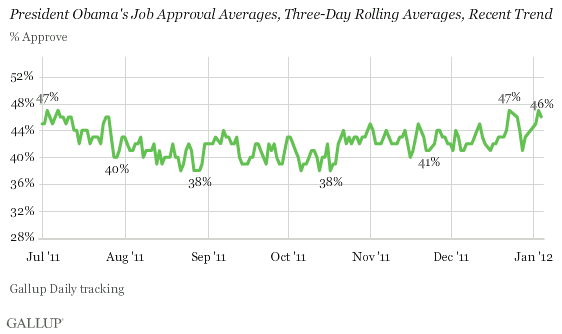PRINCETON, NJ -- Barack Obama's initial three-day average approval rating in the new year is 46%, higher than the ratings he received in most of the latter part of 2011. He was generally in the low 40% range from August through December, including monthly approval averages of 41% in August, September, and October, and 43% in November and December.

The current 46% rating for Obama, based on Jan. 2-4 polling, is one percentage point below his recent high three-day averages of 47% in Dec. 29-Jan. 3 and Dec. 21-23 tracking. The latter came during the standoff between the president and Senate versus the House Republicans over legislation to extend unemployment benefits and maintain lower payroll tax rates in 2012.
Prior to that, Obama had not had a three-day rating as high as 47% since early July. Obama registered several term-low three-day averages of 38% in August and October.
One reason for the increase in Obama's approval rating in the current polling could be the improvement in Americans' economic confidence in recent days.
Obama also had a relatively strong January last year, averaging 49% approval -- his second-highest 2011 monthly average after May's 50%.
Approval Rating an Important Gauge of Re-Election Chances
Obama's approval rating will be a critical indicator of his re-election chances this year. If he can sustain higher approval ratings through early November, his odds of winning a second term will increase. Gallup finds that all presidents since Eisenhower with approval ratings above 50% have won re-election easily. George W. Bush was re-elected in 2004 with 48% approval at the time of the election.
If Obama's approval rating reverts to the low 40% range, he would have a difficult time defeating a Republican in a two-candidate race.
One key to improving his approval rating and re-election chances is expanding his support among independents. Currently, 81% of Democrats, 42% of independents, and 10% of Republicans approve of Obama. By comparison, last January, when he had an overall monthly average of 49%, Obama's approval rating was 83% among Democrats, 47% among independents, and 13% among Republicans.
Implications
Obama's approval rating is showing some signs of improvement in the first few days of the new year, though it is unclear whether that will last. The modest bump in his approval right before Christmas disappeared after the holiday, and his approval ratings were generally in the low 40s in the week between Christmas and New Year's Day.
January brings challenges for Obama to maintain higher approval ratings, given that much of the political focus will be on the Republican nomination contest, with the GOP candidates seeking to point out Obama's shortcomings as president in order to help their chances of winning the nomination. However, later this month, Obama will have his own day in the spotlight as he delivers the State of the Union address, a unique opportunity for him to directly state his case for re-election to Americans.
Explore President Obama's approval ratings in depth and compare them with those of past presidents in the Gallup Presidential Job Approval Center.
Survey Methods
Results for this Gallup poll are based on telephone interviews conducted Jan. 2-4, 2012, on the Gallup Daily tracking survey, with a random sample of 1,544 adults, aged 18 and older, living in all 50 U.S. states and the District of Columbia.
For results based on the total sample of national adults, one can say with 95% confidence that the maximum margin of sampling error is ±3 percentage points.
Interviews are conducted with respondents on landline telephones and cellular phones, with interviews conducted in Spanish for respondents who are primarily Spanish-speaking. Each sample includes a minimum quota of 400 cell phone respondents and 600 landline respondents per 1,000 national adults, with additional minimum quotas among landline respondents by region. Landline telephone numbers are chosen at random among listed telephone numbers. Cell phone numbers are selected using random-digit-dial methods. Landline respondents are chosen at random within each household on the basis of which member had the most recent birthday.
Samples are weighted by gender, age, race, Hispanic ethnicity, education, region, adults in the household, and phone status (cell phone only/landline only/both, cell phone mostly, and having an unlisted landline number). Demographic weighting targets are based on the March 2011 Current Population Survey figures for the aged 18 and older non-institutionalized population living in U.S. telephone households. All reported margins of sampling error include the computed design effects for weighting and sample design.
In addition to sampling error, question wording and practical difficulties in conducting surveys can introduce error or bias into the findings of public opinion polls.
For more details on Gallup's polling methodology, visit www.gallup.com.
